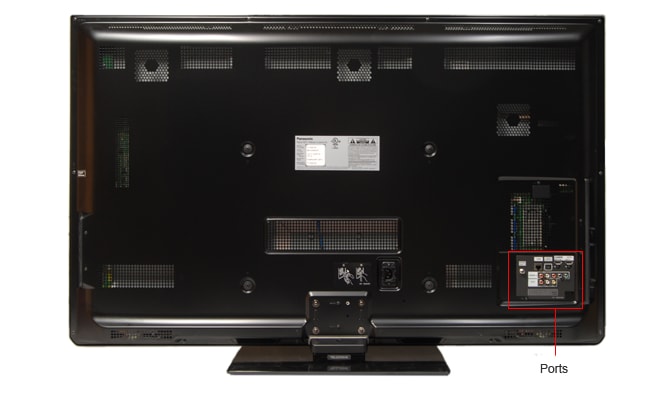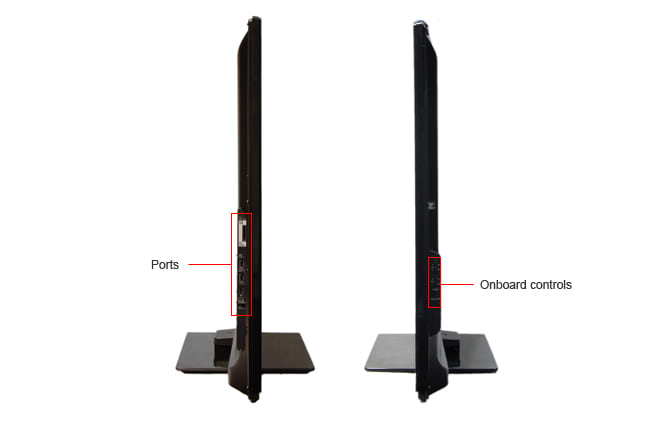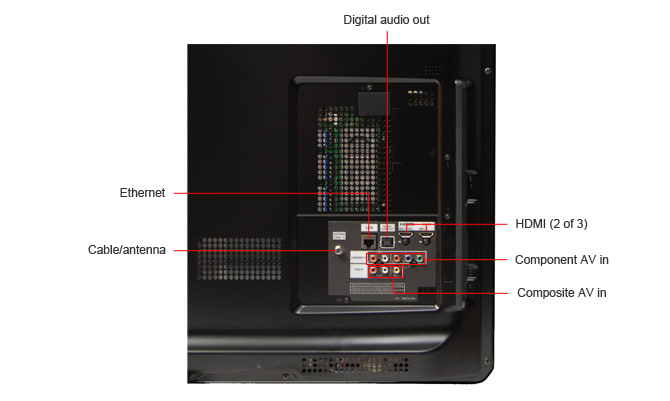Introduction
Tour & Design
The Panasonic TC-P50ST30 has an attractive design that's much improved over last year's boxy TC-P50VT20. The bezel is more subdued, with a semi-transparent gloss. The frame is thinner, and hard edges have been smoothed to wrap around to the back.

The back of the TV is plain, with all the ports gathered in one corner. For information about the ports on the back of the Panasonic TC-P50ST30 see our Connectivity section.

The sides of the Panasonic TC-P50ST30 are quite a bit thinner than last year, but still wide enough to fit a few ports on one side and the onboard controls buttons on the other side. For information about the ports on the sides of the Panasonic TC-P50ST30 see our Connectivity section.

The stand seems sturdy enough to support that large and very heavy TV panel, joined by a metal neck that screws in securely to both parts. The TV panel can freely swivel about 10 degrees to either side. Fortunately, with the huge viewing angle this TV has, you may not even need even need to swivel it at all.
The standard assortment of button is here. We like that they're actual buttons rather than the touch-sensitive areas that a lot of the Samsungs are using, which can accumulate fingerprints all over your bezel.
The remote control that ships with the Panasonic TC-P50ST30 has large, very clearly labeled buttons (a bit geriatric, if you ask us). Despite the appearance, we love the red backlighting feature that makes it much easier to operate in the dark. The most commonly used buttons – volume, power, and menu controls – are easy to locate without even looking down. The remote can also be programmed to operate other Panasonic AV devices. It is not, however, a universally programmable remote.
The Panasonic TC-P50ST30 ships with the remote control & batteries, stand & requisite screws, a USB dongle for WiFi, a weird USB hub with extension cord, instruction manual, and assorted documentation.
Blacks & Whites
The Panasonic TC-P50ST30 produced a remarkably deep black level of only 0.02 cd/m2. That's even better than last year's TC-P50VT20, another plasma TV. Both are far better than the Sony and Samsung LCD TVs we've pulled in for comparison. (More on how we test Black Level.)
One of our biggest complaints about last year's Panasonic TC-P50VT20 was the dim screen, which became an even bigger problem when you wore the tinted 3D glasses. It appears that Panasonic addressed that problem with the new TC-P50ST30, because it's considerably brighter. Of course, being a plasma TV, there are still some issues. The peak brightness varies widely depending on how much white content is on the screen (see White Falloff for details). Also, all the plasmas we've reviews lag far behind LCDs in producing a bright white. You can see how big that difference is in the chart below. (More on how we test Peak Brightness.)
Thanks to a much improved peak brightness and an even darker black, this year's Panasonic TC-P50ST30 has a much wider contrast ratio than last year's TC-P50VT20. While the Samsung and Sony TVs we pulled in for comparison are both lacking such a deep black level, the peak white was bright enough to make for impressive contrast ratios. ( More on how we test Contrast.)
The Panasonic TC-P50ST30, like so many plasmas, has a hard time maintaining a consistent black level. Look at the chart below. The area on the right end of the scale represents how deep the black level is when the screen is displaying mostly black, with just a little white. At the left end of the chart is the black level when there's just a patch of black that's surrounded by white. Notice how much brighter that black level gets. (More on how we test Tunnel Contrast.)
The opposite of the test above, we see how well a TV maintains a consistent peak brightness as the area of white on the screen expands and contracts. In short, the Panasonic TC-P50ST30 does not do so well. The issue typical of plasmas is that an all-white screen will be much dimmer than a small patch of white. It's plasma, folks, and if you had every pixel blasting it's brightest, hottest white at the same time, the TV would probably melt. (More on how we test White Falloff.)
The Panasonic TC-P50ST30 had a pretty perfect uniformity, as far as we could see. There was none of the illumination problems we see with LCDs. (More on how we test Uniformity.)
The greyscale gamma test tells us how well a TV transitions from black to white in the greyscale. First, we're looking at the smoothness of the line in the chart below. It's very smooth; we're not seeing any areas that go flat or create jaggies, which would indicate portions of the greyscale that the Panasonic TC-P50ST30 simply can't produce. We're also looking at the slope of the curve. An ideal slope is somewhere between 2.1 and 2.2, so this TV's performance of 2.32 is quite good.( More on how we test Greyscale Gamma.)
Overall, great job, Panasonic.
Color Accuracy
The Panasonic TC-P50ST30 had a god performance in our color temperature consistency test, but it's not perfect. As you can see, as the signal dims, the whites tend to warm. It's not a huge error, though, so you may not even notice. (More on how we test Color Temperature.)
The Panasonic TC-P50ST30 had some minor problems in our RGB color tests. As you can see in the chart below, the brightest portion of the green channel had a hard time displaying details. We had a very hard time calibrating this TV precisely because the bright greens were absent, while the blue and red channels were nearly perfect. (More on how we test RGB Curves.)
The strips below are digital recreations of the information we collected from each of the 255 values in the red, green, and blue channels. You'll see the Panasonic TC-P50ST30 compared to three similar TVs, as well as an ideal response curve.
The Panasonic TC-P50ST30 managed to adhere very closely to the rec. 709 color standards, the international standard for how colors should appear in the HD format. (More on how we test Color Gamut.)
The table below has all the nerdy, numeric details.
Motion
The Panasonic TC-P50ST30 definitely has some issues with motion. You want smooth motion? No problem. This TV can deliver, especially if you engage the Motion Smoother feature (Off, Weak, and Strong settings). This feature does a great job of rescuing the fine details that are typically lost in a moving object. (More on how we test Motion.)
The real problem is artifacting. When an object is in motion, it takes on a whole lot of color banding, weird trailing, blocky artifacts, and more. It's really problematic, especially if you're looking at it up close. Should you be sitting 10 feet back... well, maybe it's not such a problem. But we can't imagine that you want to buy a TV and rely on your distance or bad eyesight to gloss over the problems. The artifacts were so heavy handed that we went back and ran the tests again in all the picture modes, then tweaking all the processing features to try and shake it. No deal. This TV has problems with motion artifacting.
The Panasonic TC-P50ST30 handles native 24fps content (such as Blu-Ray movies) just fine. But make sure that you locate the "3:2 pulldown" setting in the Advanced Picture menu and set it to "On." Leaving it in "Auto" will not cut it, and results in big problems for certain types of patterns. (More on how we test 3:2 Pulldown and 24fps.)
The Panasonic TC-P50ST30 has a native 1080p (1920 x 1080) resolution, but a lot of the video you'll be feeding it will be of a lower resolution. Normally, this test uses a series of high contrast, high frequency patterns at alternate resolutions, and we see how badly the TV screws it up. Unfortunately, this test assumes that a TV will have no problem in its native resolution. Guess what? The Panasonic TC-P50ST30 is terrible at this test in *every *resolution. However, we don't dock points anywhere for screwing up the test in its native resolution, so we'll be doing our penalizing here. (More on how we test Resolution Scaling.)
480p
The 480p content was the only resolution resolution we examined that showed no problems. This is typical. We never see problems with 480p.
720p
The 720p content we examined had a very hard time with high contrast, high frequency patterns, just like in its native resolution.
1080i
The 1080i content was just as bad as the native resolution.
3D
Last year we were amazed at how much better plasma TVs were than LCDs at display active shutter 3D content. This year we're amazed again. At the time we're writing this, we have the new Sony KDL-55EX720 and the Panasonic TC-P50ST30 side-by-side. We also reviewed every significant active shutter 3D TV last year. Watching one, then the other, is world of difference. The Panasonic plasma has so much less crosstalk. It's actually watchable (that's about as far as our praise for 3D TVs will extend). The Sony, by comparison, is actually painful to watch due to all the crosstalk, reminding us why we hate 3D.
The Panasonic TC-P50ST30 loses a huge amount of contrast when you put the 3D glasses on. That shouldn't come as a surprise, as they're essentially polarized sunglasses. Interestingly, the black level actually got a little brighter, which might be due to some color and contrast correction that the TV is performing to correct for the glasses.
Despite the drop in contrast, we're very happy to see how much better the performance is compared to last year's Panasonic TC-P50VT20. That TV had a much dimmer screen to start with, so when you put the glasses on it was difficult to even see the screen. This is a huge improvement.
The Panasonic TC-P50ST30 has a harder time maintaining a consistent color temperature in 3D mode, but the performance really isn't that bad, compared to other 3D TVs we've tested.
The Panasonic TC-P50ST30 color curves were not nearly as good in 3D as they were in 2D (no surprises here). The red channel is particularly dim. The blue and green channels are uneven and missing a lot of the finer gradients.
The color gamut shrinks in 3D mode, undersaturating the reds and blues. However, the white point and green are not shifted too far.
Crosstalk is what happens when an image intended for one eye leaks into the other eye. It's one of the biggest factors in the breakdown of the 3D effect.
Surprisingly, the Panasonic TC-P50ST30's crosstalk actually got worse compared to last year. The biggest problem still occurs when black objects are on a white background, but most color combinations got a little worse. We're guessing that this might be due to the increased contrast compared to last year. The contrast went up, and so did the crosstalk. On the plus side, the contrast went up about 175%, but the black-white crosstalk only went up by 50%.
It's worth pointing out that, overall, there's far less crosstalk than comparable LCD TVs. We prefer plasma by a long shot.
The Panasonic TC-P50ST30 does not include glasses with purchase. You'll need to buy those separately, which run about $100-150 per pair. (No one said nausea and eyestrain come cheap!) The glasses design for 2011 is a little less ostentatious than last year's, and we're pleased to see that they seem to weigh less and have better weight distribution. After 10 minutes, we almost forgot we had them on.
*NOTE: our 3D HDTV testing is under development, which is why these sections have no scores. Please check back for our full tests, scores and more extensive testing in the near future. *
Viewing Effects
The Panasonic TC-P50ST30 has a native 1080p (1920 x 1080) display, and can adequately handle all standard NTSC resolutions.
The Panasonic TC-P50ST30, like most plasmas, has a fantastic viewing angle. As you can see in the chart below, it far exceeds the typical viewing angle of an LCD, like the Samsung and Sony models here. This is one of the most frequently cited benefits of plasma TV. (More on how we test Viewing Angle.)
The Panasonic TC-P50ST30 does a better job of staving off reflectance than a lot of cheaper plasmas that we've seen. Yes, in areas of total darkness, you'll probably be able to see yourself or your friends in the room. That's what you get with a plasma. But lighter or colored areas will be less affected by ambient light. (More on how we test Reflectance.)
There are a few video processing features here, but they don't do much to add to the picture quality.
Calibration
[

](http://www.displaymate.com/)The Panasonic TC-P50ST30 was surprisingly easy to calibrate. We put the TV in Cinema mode the colors instantly shifted very, very close to the rec. 709 standard. As you'll see in the chart below, we simply turned off some of the video processing features. Note that in Cinema mode, you'll lost access to the "Pro Settings" submenu.
The Panasonic TC-P50ST30 has a handful of video modes for one-touch calibration without all of those fiddly little settings.
Connectivity
The Panasonic TC-P50ST30's selection of ports is a sign of the times. There are fewer and fewer ports for older devices on these new, expensive, high-end TVs. First and foremost, it's a way to keep manufacturing costs down, of course. But secondarily, the TV manufacturers do not want to be chained to the past and your long line of devices like VCRs, DVD players, and old cameras and camcorders (even if that same manufacturer, like Panasonic, made those devices, too). The Panasonic TC-P50ST30 has just one component AV input and one composite AV input. Conspicuously missing: no VGA input and no analog audio output. Panasonic urges you (well... forces you) to get with the times.

Don't you worry, though. There are plenty of connections for modern devices: three HDMIs, two USBs, an SD/SDHC/SDXC card slot, an ethernet port, and an included USB WiFi dongle. We're not entirely sure why Panasonic didn't just make the WiFi feature built-in. They don't expect you to just pop it into the side of the TV, either. The TV ships with a USB docking station specifically designed to plug the WiFi dongle into. Great, all the convenience of wireless internet, now with extra wires.

If you're really into wiring up your home theater system, you'll love the Panasonic TC-P50ST30. In additional to DLNA support for home media servers, you can string up a whole system of networked surveillance cameras and control them from the TV.
To learn more about the internet and local media playback, jump to Multimedia and Internet page.
The ports on the Panasonic TC-P50ST30 are well-placed and clearly labeled. The TV panel swivels on its base, making the rear ports all the easier to get to.
Audio & Menus
The audio options are simple, perhaps because Panasonic realized that the built-in speakers will only take you so far, and so many people are investing in separate audio systems. You'll only find bass and treble controls in the menu; there's no equalizer. There's only a couple of audio processing features. A.I. Sound equalizes volume levels so you don't get any sudden bursts of loudness. The Surround mode tries to emulate a surround sound system, and kind-of gets there, but not really. The Bass Boost... any guesses? Yes, you're correct. It boosts the bass.
Overall, the sound quality is rather good, at least for a TV. We could feel the bass in our feet, which is far better than a lot of TVs we've reviewed. The stereo effect is good, and there was a clarity that allowed us to hear certain tones that many TVs miss.
If you want to expand, there's a digital audio output. You're out of luck if you need an analog audio out, though.
The menu on the Panasonic TC-P50ST30 is similar to what we've seen on Panasonics for the last few years. It's not particularly attractive, but everything is clearly labeled and it's easy to find your way around. We found the same frustrations as last year, as well. For instance, when you're scrolling through the Picture settings and you land on "Brightness," you'd think that you should click the OK button on the remote. No, in fact you're supposed to hit the left and right buttons on the d-pad, which will cause the feature to activate. It's a small but annoying problem.
Before you get too far into the calibration process, know that a lot of submenus will be greyed out depending on which modes you have selected. For example, the Pro Settings submenu is inaccessible if you're in Cinema or another preset mode.
The instruction manual that ships with the Panasonic TC-P50ST30 is lengthy and informative. Everything is covered here, even if its not in the deep detail you might like. You can find the Panasonic TC-P50ST30's manual online here.
Multimedia & Internet
The Panasonic TC-P50ST30 has stated that they are continuing to expand their Viera Cast platform of streaming content and internet services, but we're not seeing much development at the time of this publication. Not only is the interface just as sluggish and clunky as before, but many of the content partners remain the same. Sure, it's a lot better than when the Panasonic premiered the VT20, their first 3D TV, twelve months ago, but we expected more.
The interface is waaaay to slow for anyone accustomed to internet browsing (that is to say, to everyone that would likely buy this TV). You're presented with the series of stacked windows, seven windows in each layer, along with the live video feed (your cable or movie signal) in the center so you can browse and watch TV at the same time. The load times are painful and the cute animation of gliding from one layer to the next only remind you of how long it's taking.
At their press conference at CES this year, Panasonic promised a broad expansion of the Viera Cast platform, and we've yet to see a significant expansion. As you can see in the photo, Panasonic has broken up the "apps" (please don't sue us for using the term "apps", Apple) by category. However, many of the categories have a only a couple entries. Anything noteworthy is already pre-loaded onto the TV when you run a system update.We can only assume that this will fill out as the year rolls on, but we said the same thing last year. At this point, they're trailing Sony's TVs by quite a bit.
The preloaded features include: Facebook, Skype, Netflix, YouTube, AccuWeather, Amazon on demand, Fox Sports, CinemaNow, Twitter, NBA Game Time, MLB.tv, UStream, Pandora, Picasa, and the AP wire service, along with the dreaded Dracula's Coffin game.That's not a bad list, but it's the minimum you should expect in this fast changing race for the "most connected TV."
The TV also supports DLNA home networks over ethernet or WiFi.
The Panasonic TC-P50ST30 can play photos, music, and video clips from either USB mass storage devices or the SD/SDHC/SDXC card slot. When you pop a device in, you'll be asked to first select the drive (there are two USB ports), then select a media type. Your media appears as a series of thumbnails. There are plenty of options for creating slideshows and playlists. For a complete list of supported media types, see the manual.
The Panasonic TC-P50ST30 does not support any other type of media.
Power Consumption
Plasma TVs require more power than LCD TVs, typically a lot more. Unlike an LCD, you can't lower the backlight to reduce power consumption. (More on how we test Power Consumption.)
As you can see in the chart below, it's more than three times the cost of the new Sony KDL-55EX720, an LED-edgelit LCD. it's also more expensive than last year's Panasonic TC-P50VT20, another plasma TV. We can only guess that the brighter screen on the new TV might have something to do with that.
Vs Sony KDL-55EX720
Value Comparison Summary
The Sony KDL-55EX720 is five inches larger, but nearly a thousand dollars more expensive (that's about $180 per inch, if your counting). Of course, that's not where the math is really coming from. The EX720 series uses LED-edgelighting that allows for an incredibly thin frame and great energy savings. In terms of the performance, these TVs are split right down the middle. Sony had the advantage with color and motion performance, as well as a slightly higher contrast. Sony's streaming content is also far superior. The Panasonic TC-P50ST30 offers much better 3D performance, a wider viewing angle, and deeper blacks.
You can't ignore the price here, however. If people are willing to shell out the money, there are better Panasonic for 2011. If you're looking for a bargain, you could do a lot worse than the Panasonic TC-P50ST30. Also, consider some of the hidden costs for each. Neither TV comes with 3D glasses, which run about $100-150 per pair. As for WiFi, the Panasonic TC-P50ST30 includes a WiFi adapter, while the Sony EX720 requires separate purchase.
Blacks & Whites
The Panasonic TC-P50ST30 was very close to the outstanding contrast ratio of the Sony KDL-55EX720, but each excelled in a different way. The Panasonic, as a plasma, had a far deeper black. The Sony's black level was good, but its peak brightness was much better.
Color Accuracy
The Sony KDL-55EX720 came out the winner in the contest for best color, offering a steadier color temperature and better, smoother RGB color curves.
Motion
The Panasonic TC-P50ST30 has some big problems with motion artifacting, which cost it a lot of points. The Sony KDL-55EX720 was far better in this regard.
Viewing Effects
There's no comparison for viewing angle. The Panasonic TC-P50ST30 is a plasma TV, which has nearly four times the viewing angle of the LED-edgelit LCD Sony EX720.
Connectivity
The Sony KDL-55EX720 is definitely better equipped in terms of ports. There's an extra HDMI, a VGA input, and an analog audio output. If you don't need these things, maybe the Panasonic will suffice.
Other Comparisons
The Sony EX720 offers a far better collection of streaming content than Panasonic. If you're not looking for much more than Netflix and a music streaming service, they're evenly tied, but Sony's TVs are full of all sorts of little video Easter eggs. You never know what you'll find.
In terms of 3D performance, Panasonic is far and away the winner. Plasmas simply display active shutter 3D better than LCDs.
Vs Samsung UN46C7100
Value Comparison Summary
The Samsung UN46C7100 looks and feels like a very high-end TV. Samsung does the best job making you feel like you spent all that money on the right product – beautiful design, a slick menu, and a great selection of streaming content. Of course, it's not a perfect TV, and it's our job to take it apart. The TV is quite expensive, though it comes with two pairs of 3D glasses included, so that's about $200-300 right there. The 3D quality is quite poor compared not the Panasonic plasma, but we don't think you should expect much from 3D at all. The other big problem with this Samsung was a narrow viewing angle, also beaten by the Panasonic TC-P50ST30. The Samsung UN46C7100 certainly isn't cheap. Naturally, the newer 2011 Samsung 3D TVs are going to cost less, but you might be able to find this older model on sale as retailers are looking to clear their stock.
Blacks & Whites
The Samsung UN46C7100 could not match the Panasonic TC-P50ST30 for black levels, but it did manage a much brighter white. It could still not beat the Panasonic in contrast ratio.
Color Accuracy
The Samsung UN46C7100 displayed a more even color temperature and slightly smoother color curves.
Motion
The Panasonic TC-P50ST30 had a lot of trouble with motion artifacting and was easily topped by the Samsung.
Viewing Effects
Samsung's LCD TVs have shown a consistent weakness with viewing angle. The Panasonic TC-P50ST30, a plasma, absolutely dominated the Samsung UN46C7100, offering a viewing angle over seven times wider.
Connectivity
The Samsung UN46C7100 offers one additional HDMI input, a VGA input, and an analog audio output. However, the component and composite AV inputs are shared, while the Panasonic TC-P50ST30 has a dedicated set of inputs for each type. The Panasonic TC-P50ST30 also ships with a USB dongle for WiFi connection, while the Samsung requires additional purchase.
Other Comparisons
Samsung's streaming content selection is about the same or a little better than the Panasonic. Both have Netflix and other solid brand name partners.
In terms of 3D display, the plasma Panasonic is far superior. Plasmas seem to be less susceptible to crosstalk, which kills the 3D effect.
Vs Panasonic TC-P50VT20
Value Comparison Summary
The ST30 series may or may not be the direct replacement for the VT20/VT25 series from last year. It may be just be a new and different series of 3D plasmas for 2011. Either way, we're going to make some comparisons here.We were very impressed with most of the Panasonic TC-P50VT20 when we reviewed it last year. The biggest weakness was the dim screen, which narrowed the contrast ratio and made 3D viewing very difficult once you donned the tinted 3D glasses. This year, the Panasonic TC-P50ST30 had a dramatically improved contrast ratio, so kudos to the engineers for that. The designers also stepped up their game and overhauled the fat, boxy look of last year's plasma TVs.The price has also come down considerably.
On the downside, the motion performance is noticeably worse. We're not sure why, but we saw a lot of artifacting. Also, the Viera Cast streaming content platform has few improvements since premiering last year. Yes, the new TC-P50ST30 is a much better bargain, considering the price drop, but don't look for a miracle TV here.
Blacks & Whites
When we reviewed the Panasonic TC-P50VT20 last year, we bemoaned the dim screen, which brought down an otherwise great TV. It wasn't just that the screen was dim. We've seen plenty of plasmas like that. The real problem was that the TV was designed for 3D display, and wearing the 3D glasses is the same as putting on some Ray-Bans while you watch TV, which reduced the contrast ratio down to nothing. Thankfully, Panasonic seemed to address this issue in the new TC-P50ST30. The blacks are blacks, the whites are brighter, and the contrast is wider. You still lose a lot of contrast when you put the 3D glasses on, but this time you can afford to lose some and still see the picture.
Color Accuracy
The newer Panasonic TC-P50ST30 was better at maintaining a consistent color temperature, and managed to create smoother RGB curves. It's a solid, overall improvement.
Motion
We're not sure what happened with the Panasonic TC-P50ST30 this year, but the motion artifacting dramatically increased and was quite noticeable.
Viewing Effects
The viewing angles of these two plasma TVs were both excellent.
Connectivity
The Panasonic TC-P50ST30 is slimming down compared to the chubby TC-P50VT20. As such, there's less room for ports (it's also cheaper to manufacture). There's one less HDMI, one less composite AV input, one less component AV input, and no VGA input.
Other Comparisons
The streaming content has not improved since last year, as least not as much as we'd hoped. They've added Netflix and some other features, but not the landslide of new content partners we'd been hoping for.
In terms of 3D performance, the improved contrast ratio on the new Panasonic TC-P50ST30 has made a big difference in the sheer watchability of 3D content.
Conclusion
Series Comparison
PxxST30 Series
There are four models in the Panasonic ST30 plasma TV series, ranging from 42 inches to 55 inches. All are capable of 3D display, and all share the same jack pack of ports. The price for 3D has dropped considerably since last year, and there has been some measurable improvement in quality. As of this publication, there are only two new Panasonic 3D plasma series, this and the highest-end GT30 series, which has just one 55-inch model.
Meet the tester
David Kender oversees content at Reviewed as the Editor in Chief. He served as managing editor and editor in chief of Reviewed's ancestor, CamcorderInfo.com, helping to grow the company from a tiny staff to one of the most influential online review resources. In his time at Reviewed, David has helped to launch over 100 product categories and written too many articles to count.
Checking our work.
Our team is here to help you buy the best stuff and love what you own. Our writers, editors, and experts obsess over the products we cover to make sure you're confident and satisfied. Have a different opinion about something we recommend? Email us and we'll compare notes.
Shoot us an email